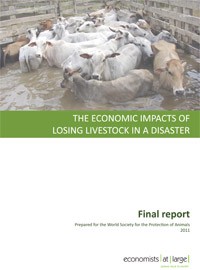This literature review investigates the “economic impact of losing livestock in a disaster”. It covers a wide range of material relating to the role of livestock in development, the economics of disasters, the treatment of livestock in disaster recovery efforts, and case studies on particular disaster events.
The purpose of this research is to highlight the current state of the literature relevant to livestock and disasters and to suggest future research areas that would help to understand better the impacts of losing livestock in a disaster.
This review focuses in particular on low-income countries. This is because livestock are extremely important to economic development and welfare in most low-income countries. Animals represent more than food — they represent livelihoods. When people are affected by natural disaster, their animals (and thus their livelihoods) are also affected. As experts in this field have put it:
From a global perspective, one of the most pressing needs [in disaster relief] is to improve livestock relief programming with communities who rely heavily on livestock for their social and economic well-being.
Source: LEGS 2009 p2
As such, this report reviews literature that relates to livestock in economic development, and also to the way disasters impact on economies. Considerable research has focused on the role of livestock in economies, and at the economic effects of natural disasters. We review the main themes of this work in the two main parts of this report. In doing so, we hope to outline, explain and expand on the value of livestock and their role in disaster recovery, and to make this importance easier to demonstrate to a wider audience.
Livestock and the economy
In high-income countries, livestock are mainly treated as a financial asset and one of many sources of food. This is in stark contrast to low-income countries, where livestock have a range of functions. Animals provide meat, milk and eggs; they assist with ploughing fields; they can be sold for cash and play a role in cultural identity. In addition, livestock in low-income countries have direct and indirect values relating to food, agriculture, savings and cultural values.
When livestock losses occur due to a disaster, it is direct values – those that can be estimated using market prices – that are generally considered in evaluating the cost of the losses. However, such valuation rarely incorporates the indirect values of livestock, which can be more difficult to observe, but often more important than the direct financial loss incurred in a disaster.
All these factors are affected when livestock are lost in disasters. Our literature review suggests that these values are often not considered in economic and general literature. We believe that an understanding and acknowledgment of these indirect roles is crucial in understanding the role of livestock in developing economies, and in understanding why their loss in natural disasters is so damaging.
Modelling the impact of disasters
Economists have attempted to model the costs of disasters, both direct and indirect, using regression analysis. We examine the efficacy of such modelling, and find that as it tends to be limited to macroeconomic factors, it sheds little light on regional effects – such as the loss of livestock.
Conclusions
In this report we show that livestock play an important and multifaceted role in low-income economies. Their many direct and indirect values make quantification of their contribution difficult. As a result, their indirect values, in particular, are often overlooked. Natural disasters take a heavy toll on low-income countries due to those countries’ exposure and vulnerability, part of which is due to their high dependence on livestock.
We conclude that the full value of livestock and the indirect economic impacts of disasters are inadequately understood in general discussion. We hope that our approach – of identifying the full values of livestock in low-income economies and applying this to the direct and indirect effects of disasters – can help future research in this area. We hope that livestock practitioners and economists will incorporate particularly indirect values into disaster recovery plans and general understanding of disasters and development. We suggest future research should focus on:
- Helping the public, organisations and donors understand the enormous role that livestock play in developing economies, and the way they are affected by natural disasters.
- Helping practitioners and the public understand whether economic valuation of a disaster incorporates indirect impacts.
- Better economic assessment of the indirect impacts of disasters.
- Assessing where modelling and economic analysis is possible or useful.
- Assisting with the development of economic modelling of livestock losses.

